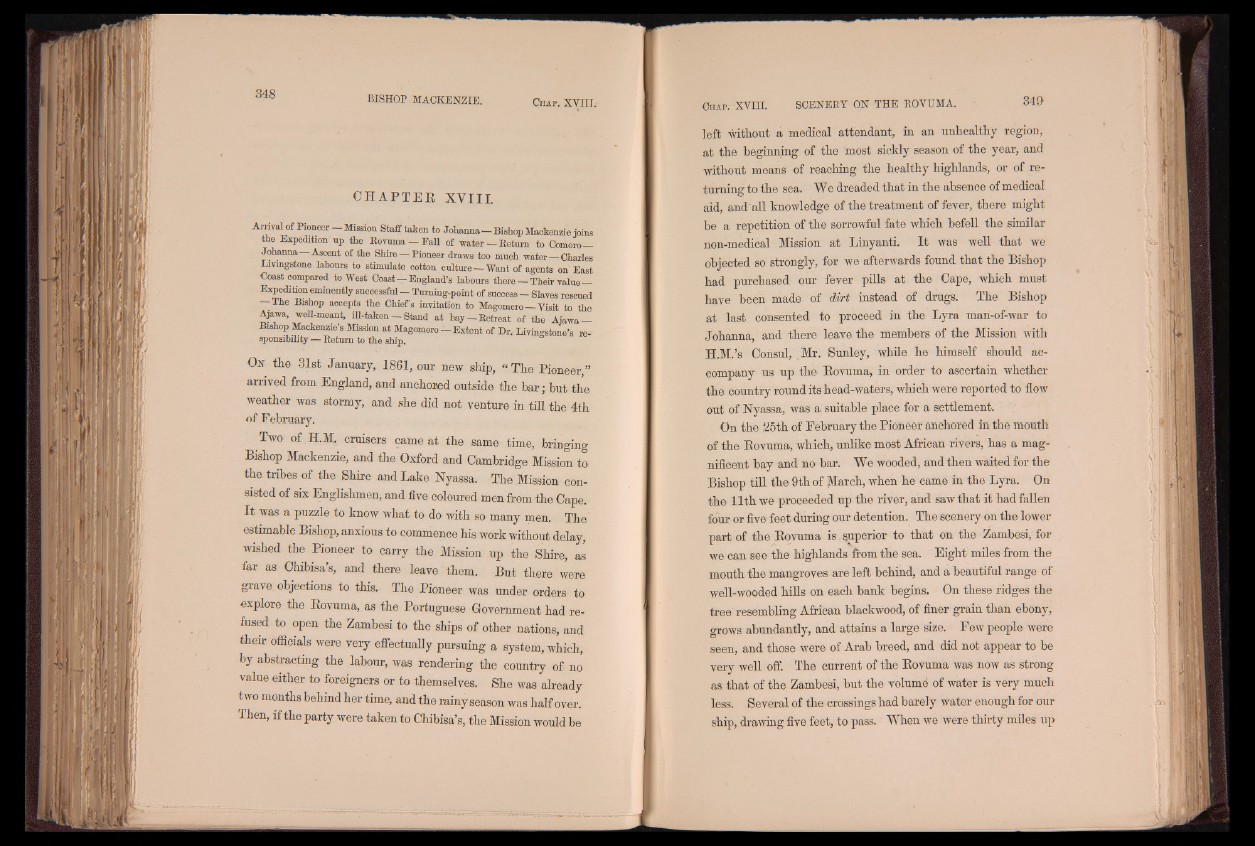
C H A P T E R X Y I I I .
Anival of Pioneer — Mission Staff taken to Johanna—Bishop Mackenzie joins
the Expedition up the Rovuma — Pall of water—Return to Comoro —
Johanna —Ascent of the Shire — Pioneer draws too much water—Charles
Livingstone labours to stimulate cotton culture —Want of agents on'East
Coast compared to West Coast—England’s labours there —Their value—
Expedition eminently successful — Turning-point of success — Slaves rescued
— The Bishop accepts the Chief's invitation to Magomero — Visit to the
Ajawa, well-meant, ill-taken — Stand at hay —Retreat of the Ajawa —
Bishop Mackenzie’s Mission at Magomero — Extent of Dr. Livingstone’s re
sponsibility —Return to the ship.
On the 31st January, 1861, our new ship, «The Pioneer,”
arrived from England, and anchored outside the bar; but the
weather was stormy, and she did not venture in till the 4th
of February.
Two of H.M. cruisers came at the same time, bringing
Bishop Mackenzie, and the Oxford and Cambridge Mission to
the tribes of the Shire and Lake ISTyassa. The Mission consisted
of six Englishmen, and five coloured men from the Cape.
I t was a puzzle to know what to do with so many men. The
estimable Bishop, anxious to commence his work without delay,
wished the Pioneer to carry the Mission up the Shire, as
far as Chibisa’s, and there leave them. But there were
grave objections to this. The Pioneer was under orders to
explore the Rovuma, as the Portuguese Government had refused
to open the Zambesi to the ships of other nations, and
their officials were very effectually pursuing a system, which,
by abstracting the labour, was rendering the country of no
value either to foreigners or to themselves. She was already
two months behind her time, and the rainy season was half over.
Then, if the party were taken to Chibisa’s, the Mission would be
left without a medical attendant, in an unhealthy region,
at the beginning of the most sickly season of the year, and
without means of reaching the healthy highlands, or of returning
to the sea. We dreaded that in the absence of medical
aid, and all knowledge of the treatment of fever, there might
be a repetition of the sorrowful fate which befell the similar
non-medical Mission at Linyanti. I t was well that we
objected so strongly, for we afterwards found that the Bishop
had purchased our fever pills at the Cape, which must
have been made of dirt instead of drugs. The Bishop
at last consented to proceed in the Lyra man-of-war to
Johanna, and there leave the members of the Mission with
H.M.’s Consul, Mr. Sunley, while he himself should accompany
us up the Rovuma, in order to ascertain whether
the country round its head-waters, which were reported to flow
out of Nyassa, was a suitable place for a settlement.
On the 25th of February the Pioneer anchored in the mouth
of the Rovuma, which, unlike most African rivers, has a magnificent
bay and no bar. We wooded, and then waited for the
Bishop till the 9th of March, when he came in the Lyra. On
the 11th we proceeded up the river, and saw that it had fallen
four or five feet during our detention. The scenery on the lower
part of the Rovuma is superior to that on the Zambesi, for
we can see the highlands from the sea. Eight miles from the
mouth the mangroves are left behind, and a beautiful range of
well-wooded hills on each bank begins. On these ridges the
tree resembling African blackwood, of finer grain than ebony,
grows abundantly, and attains a large size. Few people were
seen, and those were of Arab breed, and did not appear to be
very well off. The current of the Rovuma was now as strong
as that of the Zambesi, but the volume of water is very much
less. Several of the crossings had barely water enough for our
ship, drawing five feet, to pass. When we were thirty miles up